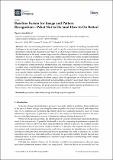Files in this item
Baseline fusion for image an pattern recognition - what not to do (and how to do better)
Item metadata
| dc.contributor.author | Arandelovic, Ognjen | |
| dc.date.accessioned | 2017-10-16T14:30:18Z | |
| dc.date.available | 2017-10-16T14:30:18Z | |
| dc.date.issued | 2017-12 | |
| dc.identifier | 251245631 | |
| dc.identifier | 57bcf6fe-b607-40fc-a220-d89080729a8c | |
| dc.identifier | 85048783786 | |
| dc.identifier | 000424411800005 | |
| dc.identifier.citation | Arandelovic , O 2017 , ' Baseline fusion for image an pattern recognition - what not to do (and how to do better) ' , Journal of Imaging , vol. 3 , no. 4 , 44 , pp. 1-16 . https://doi.org/10.3390/jimaging3040044 | en |
| dc.identifier.issn | 2313-433X | |
| dc.identifier.uri | https://hdl.handle.net/10023/11856 | |
| dc.description | (Special issue on Computer Vision and Pattern Recognition). | en |
| dc.description.abstract | The ever-increasing demand for a reliable inference capable of handling unpredictable challenges of practical application in the real world has made research on information fusion of major importance; indeed, this challenge is pervasive in a whole range of image understanding tasks. In the development of the most common type—score-level fusion algorithms—it is virtually universally desirable to have as a reference starting point a simple and universally sound baseline benchmark which newly developed approaches can be compared to. One of the most pervasively used methods is that of weighted linear fusion. It has cemented itself as the default off-the-shelf baseline owing to its simplicity of implementation, interpretability, and surprisingly competitive performance across a widest range of application domains and information source types. In this paper I argue that despite this track record, weighted linear fusion is not a good baseline on the grounds that there is an equally simple and interpretable alternative—namely quadratic mean-based fusion—which is theoretically more principled and which is more successful in practice. I argue the former from first principles and demonstrate the latter using a series of experiments on a diverse set of fusion problems: classification using synthetically generated data, computer vision-based object recognition, arrhythmia detection, and fatality prediction in motor vehicle accidents. On all of the aforementioned problems and in all instances, the proposed fusion approach exhibits superior performance over linear fusion, often increasing class separation by several orders of magnitude. | |
| dc.format.extent | 16 | |
| dc.format.extent | 1591034 | |
| dc.language.iso | eng | |
| dc.relation.ispartof | Journal of Imaging | en |
| dc.subject | Prediction | en |
| dc.subject | Arrhythmia | en |
| dc.subject | Image matching | en |
| dc.subject | Object recognition | en |
| dc.subject | QA75 Electronic computers. Computer science | en |
| dc.subject | T Technology | en |
| dc.subject | NDAS | en |
| dc.subject | BDC | en |
| dc.subject | R2C | en |
| dc.subject | ~DC~ | en |
| dc.subject.lcc | QA75 | en |
| dc.subject.lcc | T | en |
| dc.title | Baseline fusion for image an pattern recognition - what not to do (and how to do better) | en |
| dc.type | Journal article | en |
| dc.contributor.institution | University of St Andrews. School of Computer Science | en |
| dc.identifier.doi | https://doi.org/10.3390/jimaging3040044 | |
| dc.description.status | Peer reviewed | en |
This item appears in the following Collection(s)
Items in the St Andrews Research Repository are protected by copyright, with all rights reserved, unless otherwise indicated.

